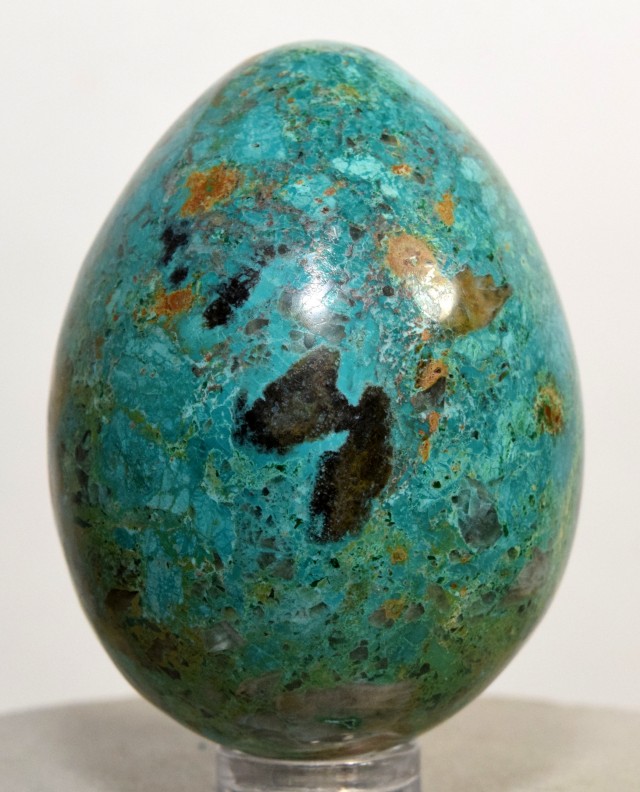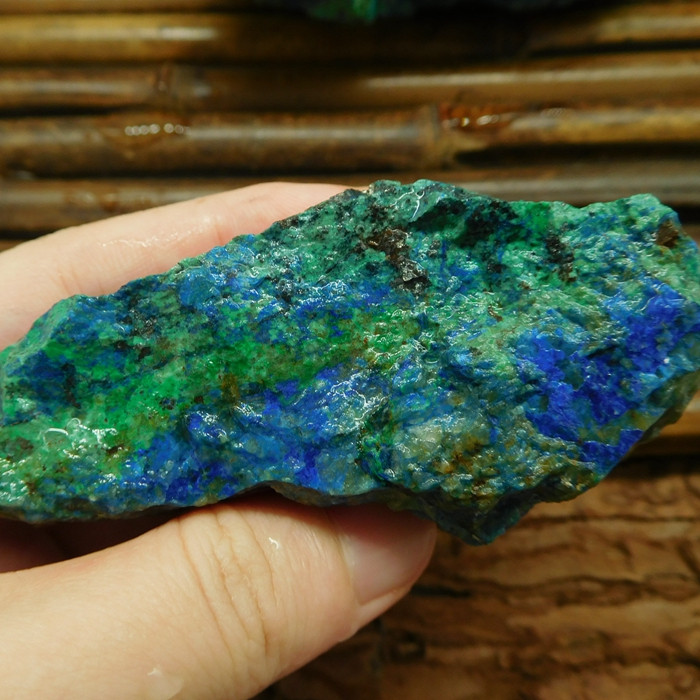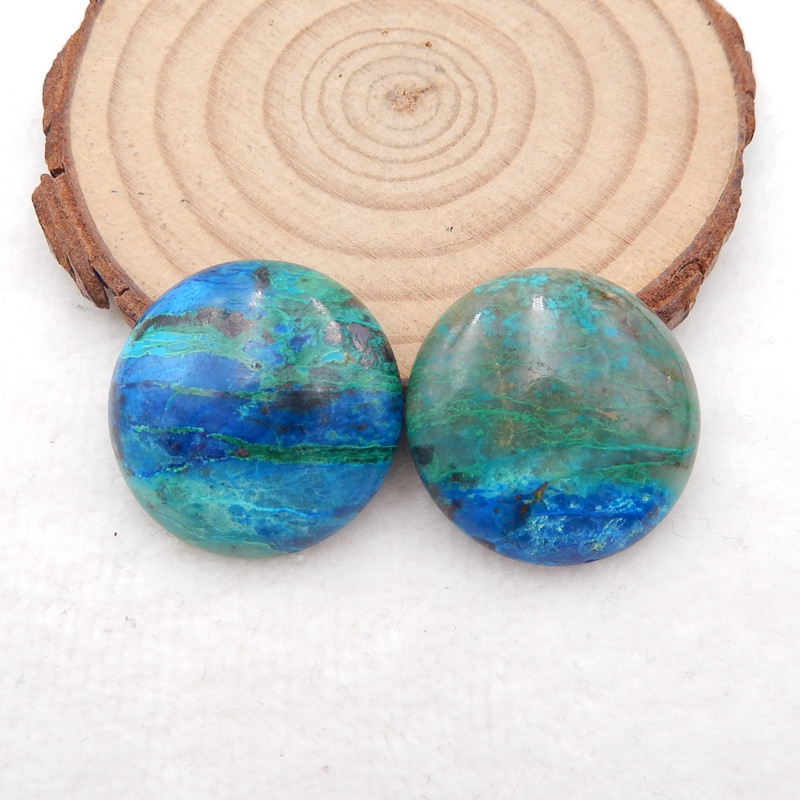
Chrysocolla Stone: Meaning, Healing Properties & More
 If you’re looking to expand your gemstone collection, allow us to introduce the chrysocolla stone. This gemstone is unique in so many ways, from its formation to its gorgeous coloring.
If you’re looking to expand your gemstone collection, allow us to introduce the chrysocolla stone. This gemstone is unique in so many ways, from its formation to its gorgeous coloring.
So, what is chrysocolla, and what makes this a must-have gemstone?
Chrysocolla is a copper silicate mineral found in deposits around the world. Its blue-green hues reflect the calming and inspiring benefits within. With a chrysocolla bracelet or ring, you’ll be ready to express your true self with confidence and ease.
Today, we’ll be covering everything you need to know about chrysocolla: its properties, origin, history, and more.
Ready to learn all about the chrysocolla stone? Let’s get started!
What Is A Chrysocolla Stone?
Chrysocolla is a copper carbonate gemstone, most often in blue to green tones. Other carbonate copper stones include malachite and turquoise. These can even mix with chrysocolla, creating beautifully patterned gems with stronger durability.
While chrysocolla is not a traditional birthstone, it makes a great alternative for turquoise, December’s birthstone. Plus, chrysocolla is more affordable than turquoise, and its cool blues match the energies of winter perfectly.
Springtime babies can enjoy this gem too! The chrysocolla zodiac stone belongs to Gemini, the lively intellectuals of the zodiac. Known for their wit and expressiveness, Geminis can harness their creativity and expression with chrysocolla.
Looking for a unique 11th-anniversary gift? Try replacing or pairing the traditional turquoise with chrysocolla. A stunning chrysocolla pendant or beaded bracelet is sure to show your loved one how special they are to you.
Now let’s find out more about what makes chrysocolla so remarkable.

Chrysocolla Specifications
Chrysocolla stones are generally composed of oxygen, copper, silica, and hydrogen. We say generally here because chrysocolla doesn't have a definitive chemical formula.
Unlike most gemstones, chrysocolla is a secondary mineral. Many well-known crystals, like sapphire and topaz, are primary minerals; they form by elements combining. When outside forces like water or pressure change these minerals’ chemical structure, you get a secondary mineral.
It’s important to note that some experts don’t think chrysocolla is a mineral. Instead, they claim it’s a hardened silica gel. However, the International Mineralogical Association (IMA) approved chrysocolla as a mineral, so we’ll follow that here.
Pure chrysocolla is fragile, with a hardness of 2-4 on the Mohs scale of mineral hardness. For reference, that’s about as hard as a fingernail or copper penny. However, certain inclusions like chalcedony can raise it to a 7.
Color: Blue, green, cyan, blackish blue, brown
Crystal structure: Orthorhombic (sometimes monoclinic)
Luster: Vitreous (if silicified) to waxy
Transparency: Translucent to opaque
Refractive index: 1.50-1.64
Density: 1.9-2.4
Cleavage: None
Let’s take a closer look at the reason behind these characteristics.

Chrysocolla Gemstone Properties
We’ve already seen how chrysocolla stands out from other gemstones. Next, we’ll break each of these down by looking at the key factors behind any gemstone: color, clarity, and cut.
First up, let’s uncover chrysocolla’s variety of colors.
Colors
If you can’t get enough of the beach, chrysocolla is the stone for you. Its colors vary from the rich blue of a deep-sea dive to the light green of sea glass peeking through the sand. Depending on its inclusions, chrysocolla can also be blackish blue, brown, and even yellow on rare occasions.
Most of the chrysocolla’s unique coloring comes from the stones it mixes with.
One of these variations is chrysocolla quartz, a light blue species. It goes by the trade name stellarite, and you can probably guess that it’s formed by chrysocolla blending with quartz.
Another popular variety is the Parrot Wing. This stone is a mixture of chrysocolla, jasper, azurite, and quartz. Its greenish-brown base is sprinkled with red, resemblant to its namesake.
Some of the color differences in chrysocolla stones come from the number of certain elements inside. Stones with more copper will more richly display chrysocolla’s signature blue-green tones.
Clarity
Another key factor in knowing your gemstone’s value is its clarity. Because inclusions are present in all gemstones, colored stones’ clarity grades are based on how visible the inclusions are.
When it comes to grading, the Gemological Institute of America (GIA) splits colored gemstones into three types. Stones with heavy, visible inclusions like chrysocolla have a Type III clarity grade.
A low clarity grade doesn’t make a stone boring, though! Some inclusions create stunning patterns, such as:
Cuprite. Chrysocolla with cuprite inclusions is dual-colored, with portions of red and bluish green overlapping.
Iron Oxide. Iron oxide inclusions lead to concentrated streaks of black or dark gray, giving the stone incredible dimension.
Cut
Chrysocolla’s variety doesn’t stop at its colors. Chrysocolla jewelry can come in oval, square, and pear cuts, to name a few.
The most popular cut for chrysocolla, however, is the cabochon cut. Cabochons are polished, unfaceted stones with a rounded top and flat base. This cut allows chrysocolla’s beautiful patterns to be front and center.
If you like the pure energy of a raw gemstone, you can also find rough chrysocolla in all its natural glory.
In fact, chrysocolla’s natural glory has been admired for centuries.

Chrysocolla Stone Legends and History
The name chrysocolla comes from the Greek words chrysos, meaning golden, and kolla, meaning glue. The ancient Greeks, starting with philosopher Theophrastus, gave the name chrysocolla to any materials used to solder gold.
This stone soon became a favorite of rulers and tribes throughout history. Let’s take a look at some ancient legends.
Chrysocolla Legends in Ancient Times
With such a long history, it’s hard to be certain about the earliest source of chrysocolla. However, most experts have settled on the city of Eilat in Israel.
According to legend, the Biblical King Solomon had a mine in Eilat where chrysocolla was first dug up. Chrysocolla later became Israel’s national stone, in part because of this story.
Over in ancient Rome, the emperor Nero had his own love of chrysocolla. Like our modern sports teams, Romans had factions that would compete in sports like gladiator tournaments and chariot races.
Nero was the patron of the most popular team, the green faction, and participated in chariot races. To honor his team, he chose green chrysocolla powder over sand to dust the arena before his match.
Another ancient ruler with a chrysocolla passion was Cleopatra. Egyptians believed this stone could help control tempers, and Cleopatra had a reputation for hers. Allegedly, she’d wear chrysocolla jewelry when meeting with her brother Ptolemy XIII to mitigate their contentious relationship.
Chrysocolla History
Traveling forward to the Middle Ages, the chrysocolla stone was a key medicinal ingredient. Based on the research Hippocrates published about chrysocolla, medical practitioners started using it for treating wounds and scars.
Chrysocolla became more of an artistic or spiritual tool as time went on. For example, painters during the Renaissance era used ground chrysocolla for paint pigment.
Native Americans believed chrysocolla could provide physical and emotional resilience. In fact, indigenous societies in North America used chrysocolla for everything from rituals to decoration.
We know where this stone started, but where can you find chrysocolla now?

Chrysocolla Stone Formation
Chrysocolla’s formation is one of its most distinct factors. It’s almost always found as a secondary mineral within copper deposits, in what’s called an oxidation zone.
In these oxidation zones, water containing carbon dioxide breaks down the copper minerals. From there, the altered minerals collect various nearby chemicals before hardening.
When chrysocolla is dug up, you’ll most likely find it in a botryoidal form, like a bundle of grapes. You’d likely see other gems like quartz, malachite, and turquoise mixed in with it, too.
So, where are these chrysocolla gemstone deposits?
Chrysocolla Mining Locations and Notable Varieties
Chrysocolla deposits are found in almost every continent. Some of these locations include the Democratic Republic of Congo, Chile, Peru, England, and the U.S.
However, the most abundant chrysocolla mines are in Peru, Israel, and the U.S.
Peru has three notable regions for chrysocolla: the Cañete province, the Acarí region, and the famous Lily Mine in Ica. The Lily Mine boasts a special variety of the gem called “drusy chrysocolla.” These stones dazzle with druses of tiny quartz crystals, creating a sparkling exterior.
As you know, Israel’s Eilat stone has quite a legendary background. Besides their history, Eilat chrysocolla stones display a captivating mixture of turquoise, azurite, and malachite.
In the US, the most abundant chrysocolla mine is in Arizona. Two signature chrysocolla varieties come out of this state: Apache chrysocolla and Gem Silica.
Apache chrysocolla mixes quartz, lapis lazuli, turquoise, jasper, and malachite to create a vibrant pattern of red, orange, and blues. Gem Silica, or chrysocolla chalcedony, is even rarer and more valuable. A high copper content gives it a striking cyan coloring, and the chalcedony increases its durability to a remarkable 7 on the Mohs scale.
That covers the basics of chrysocolla gemological properties. But what does the chrysocolla stone symbolize?
Chrysocolla Stone Meaning
Chrysocolla is called the “Stone of Communication” because it represents expression, empowerment, and wisdom.
In fact, chrysocolla is the stone of the allegorical goddess Sophia, a symbol of wisdom in many religions throughout history. Followers of Hellenistic, Greek Orthodox, Roman Catholic, and even Dianic Wicca have personified wisdom with Sophia over time.
This connection to goddess worship makes perfect sense, as chrysocolla exalts feminine energies. As the gentlest of gemstones, its soft vibrations help you balance confidence with sensitivity.
Other key spiritual benefits of chrysocolla include bringing tranquility, inspiration, and prosperity into your life. It gently teaches us how to speak our minds with compassion and conviction. Moreover, it can spark new ideas for creative solutions to problems.
All these traits make chrysocolla a great tool for anyone with a job in the arts or public speaking. Women in these fields, especially, can carry chrysocolla or wear chrysocolla jewelry to boost their confidence in sharing their knowledge.
Finding your confidence can be difficult without some soul-healing first, though. So, what is chrysocolla stone good for when it comes to healing? And what does chrysocolla do spiritually?

Chrysocolla Spiritual and Healing Properties
All gemstones possess healing powers, and chrysocolla is no different. Chrysocolla benefits for healing cover a few different areas, with a large focus on women.
Physically, chrysocolla stone benefits can relieve menstrual pain and pregnancy stress. It may help with hormones overall by regulating the thyroid and adrenals as well.
Emotionally, chrysocolla emits calming and soothing energies that help reduce distressing emotions. Anger, fear, guilt. These painful feelings can cloud our judgment.
Luckily, chrysocolla creates a balanced space to examine our emotions with clarity. From there, we can open up and speak our truth.
If you prefer chakra healing, the chrysocolla stone uses are similar. It opens up the throat chakra, where communication and expression reside. Using chrysocolla to open this chakra can help you feel centered, inspired, and confident.
Moving on from self-worth, what is a chrysocolla stone worth?
Chrysocolla Pricing and Value
Chrysocolla stone prices are somewhat varied based on where it comes from. However, they’re one of the most affordable gemstones.
In most western regions like the US, chrysocolla stone prices are generally $0.50-5 per carat. Top-quality chrysocolla gems can be over $100 per carat, but these are rare. Just remember, you’ll always find better deals shopping wholesale.
Chrysocolla’s value is mainly based on two things: color and cut. Stones with even translucence and coloring, especially pure blue, are most gemologists’ top choice.
Certain cuts, like intricate carvings, will command higher prices. But chrysocolla cuts will always tie back to the inclusions. Because pure chrysocolla is so soft, mixing it with tougher gems creates more options for cutting. Inclusions can also create striking patterns, which usually increase a gem’s value.
Which chrysocolla is the most valuable? The rare, high-quality chrysocolla chalcedony takes the cake. Arizona specializes in this type, but you’ll also find them in Mexico, Taiwan, and Peru.
Overall, a gem’s value can be subjective. If you vibe with your gemstone, trust your instinct!
Chrysocolla Care and Maintenance
As we’ve mentioned, chrysocolla is delicate. It requires special care to maintain its gorgeous shine and shape.
To keep it safe, avoid:
Steam
Ultrasonic cleaners
Acids & solvents (found in some cleaning products)
Exposure to excessive heat
Wearing it during rigorous activities
Keeping your chrysocolla gem clean is simple. For a quick clean, just hold the stone under any running water – tap water is fine! Leave it out in the sun for 20-30 minutes to dry.
When your stone needs a deep clean, lukewarm soapy water will do just fine. Dry it with a cloth after, making sure to handle it delicately.
And voila! Your stone is back to its gorgeous self.

Buy A Chrysocolla Stone Today!
That completes our comprehensive guide on chrysocolla stones! These one-of-a-kind gems are gorgeous specimens with colors and patterns beyond compare.
From its centuries-long history to the beautiful chrysocolla jewelry and cabochons we see today, this stone is admired for good reason. Each chrysocolla offers a distinct pattern and a myriad of benefits.
So, whether you use chrysocolla stones as statement jewelry or home decor, they’re sure to start a conversation. And with chrysocolla’s spiritual benefits, it’ll keep you living your best life every day!
Ready to add a unique gemstone to your collection? Shop for Chrysocolla stones today!
Search the Gemstone Encyclopedia
Related Auctions
Related Articles
Originally the Birthstones or gemstones were associated with a zodiac sign or the month of a individuals birth. Find out what your stone is and view the stones we have for sale
8th Feb 2021
There are dozens of quartz and chalcedony gems with various colors and patterns. Learn all about quartz properties and every type of quartz, from amethyst and agate to plasma and phantom quartz!
15th Oct 2020
Hackmanite is a pink to violet sodalite gem known for its unique color-change and luminescence. Learn why hackmanite is special, from its rare qualities to the types of hackmanite jewelry available.
28th Mar 2018
Latest Articles
Shortite is a rare mineral and rarer gemstone, usually found as colorless or yellow wedge-shaped crystals. Learn the value, history, and properties of shortite in this guide!
9th Dec 2024
Senarmontite is an uncommon antimony mineral mostly used industrially but occasionally collected as rare gems or pearly crystals. Find out all of the traits, uses, prices, and history of senarmontite.
27th Nov 2024
Tantalite is a group of red, brown, or black minerals containing the rare and valuable element tantalum. Discover the uses, history, prices, and properties of tantalite gemstones in this guide!
11th Nov 2024
Article Categories
How To's is where you will find helpful articles from gem Rock Auctions on how to cut gemstones, select gemstones and buy gemstones.
9 Articles





